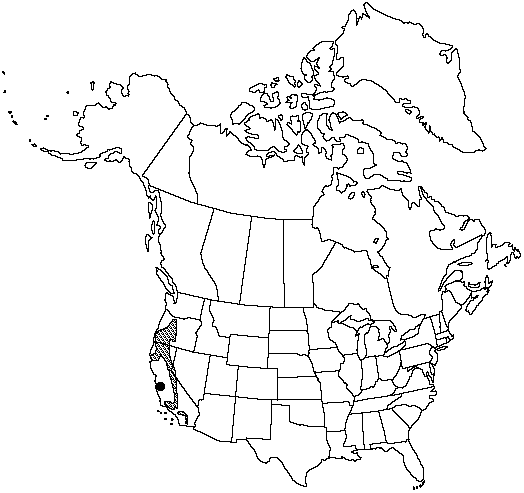Difference between revisions of "Pinus lambertiana"
Trans. Linn. Soc. London, Bot. 15: 500. 1827.
FNA>Volume Importer |
FNA>Volume Importer |
(No difference)
| |
Revision as of 18:56, 24 September 2019
Trees to 75m; trunk to 3.3m diam., massive, straight; crown narrowly conic, becoming rounded. Bark cinnamon- to gray-brown, deeply furrowed, plates long, scaly. Branches spreading, distal branches ascending; twigs gray-green to red-tan, aging gray, mostly puberulent. Buds cylindro-ovoid, red-brown, to 0.8cm, resinous. Leaves 5 per fascicle, spreading to ascending, persisting 2–4 years, 5–10cm × (0.9–)1–1.5(–2)mm, straight, slightly twisted, pliant, blue-green, abaxial surface with only a few lines evident, adaxial surfaces with evident white stomatal lines, margins finely serrulate, apex acuminate; sheath (1–)1.5–2cm, shed early. Pollen cones ellipsoid-cylindric, to 15mm, yellow. Seed cones maturing in 2 years, shedding seeds and falling soon thereafter, often clustered, pendent, symmetric, cylindric before opening, lance-cylindric to ellipsoid-cylindric when open, 25–50cm, yellow-brown, stalks 6–15cm; apophyses somewhat thickened; umbo terminal, depressed, resinous, slightly excurved. Seeds obovoid, oblique apically; body 1–2cm, deep brown; wing broad, 2–3cm. 2n =24.
Habitat: Montane dry to moist forests
Elevation: 330–3200m
Distribution

Calif., Nev., Oreg., Mexico in n Baja California.
Discussion
The largest species of the genus, Pinus lambertiana also has the longest seed cone in the genus. It is an important timber tree with harvest far exceeding regrowth. It is easily distinguished from P. monticola and P. strobus by its larger cones and thicker cone scales with larger seeds; it is somewhat less reliably distinguished by its leaves, which are slightly wider and more tapering-tipped and have some stomatal lines evident on the abaxial surfaces (the lines not evident in P. monticola and P. strobus). A "sugary" resin high in cyclitols exudes from the sweet-scented fresh-cut wood.
Selected References
None.